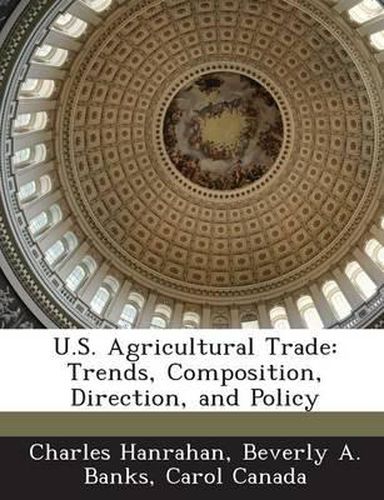U.S. Agricultural Trade
Charles Hanrahan,Beverly A Banks,Carol Canada

U.S. Agricultural Trade
Charles Hanrahan,Beverly A Banks,Carol Canada
U.S. agricultural exports for FY2006 are forecast by the U.S. Department of Agriculture at $68 billion. Agricultural imports are expected to reach $64.5 billion. The agricultural trade surplus, projected to be $3.5 billion, is at its lowest level in 19 years. Exports of bulk commodities (e.g., soybeans, wheat, and feed grains) remain significant, but exports of high-value products (HVPs), such as meats, fruits, and vegetables, are increasing. HVPs accounted for 62% of total U.S. agricultural exports in FY2005. Leading markets for U.S. agricultural exports are Canada, Mexico, Japan, China, the European Union, Taiwan, and Korea. The United States dominates world markets for corn, wheat, and cotton. Brazil has overtaken the United States as the world’s leading supplier of soybeans. Brazil is the world’s leading supplier of beef to world markets, while the U.S. share has declined since the U.S. discovery of a cow infected with “mad cow disease” in 2003. The United States, European Union, Australia, and New Zealand are dominant suppliers of dairy products in global agricultural trade. Most U.S. agricultural imports are high-value products. For some imports (grains, meats, horticultural products), similar products are produced in the United States; production of other categories of imports (bananas, coffee, cocoa) is very limited. The biggest import suppliers are the European Union, Canada, and Mexico, which together provide 58% of total U.S. agricultural imports. Australia, Brazil, New Zealand, Indonesia, and Colombia are also major suppliers of agricultural imports to the United States. Among the fastest-growing markets for U.S. agricultural exports are Canada and Mexico, both partners with the United States in the North American Free Trade Agreement (NAFTA). U.S. agricultural exports to China, recently a member of the World Trade Organization, have grown at an annual rate of 16% since 1992. Both the EU and the United States subsidize their agricultural sectors, but overall the EU out-subsidizes the United States. Recent reforms of the EU’s Common Agricultural policy shift substantial spending into direct income support decoupled from production and into rural development. Canada supports some sectors (e.g., dairy and poultry) more than others. Australia provides less support to its agriculture. Single desk sellers with monopoly powers operate wheat markets and markets for some other commodities in Canada and Australia. Export subsidies are more important in the EU than in the United States; border measures (tariffs) are more important in Canada than in either the United States or the EU. Australia operates a mix of trade measures. The United States is the dominant supplier of foreign food aid, followed by the EU, Canada, and Australia. U.S. and other major food aid donors provide commodities mainly for development assistance or emergency relief.
This item is not currently in-stock. It can be ordered online and is expected to ship in approx 2 weeks
Our stock data is updated periodically, and availability may change throughout the day for in-demand items. Please call the relevant shop for the most current stock information. Prices are subject to change without notice.
Sign in or become a Readings Member to add this title to a wishlist.

